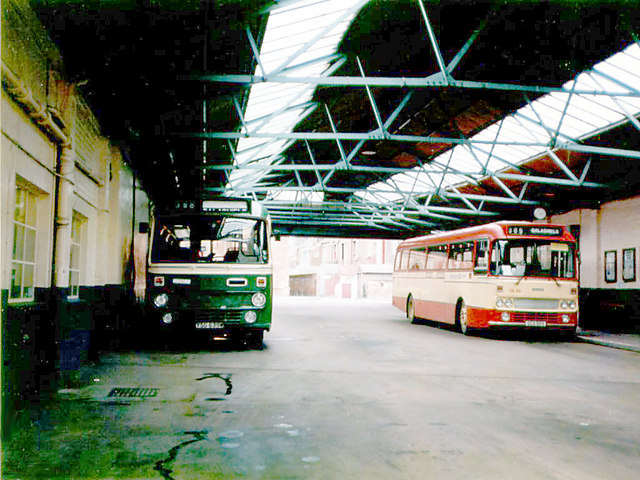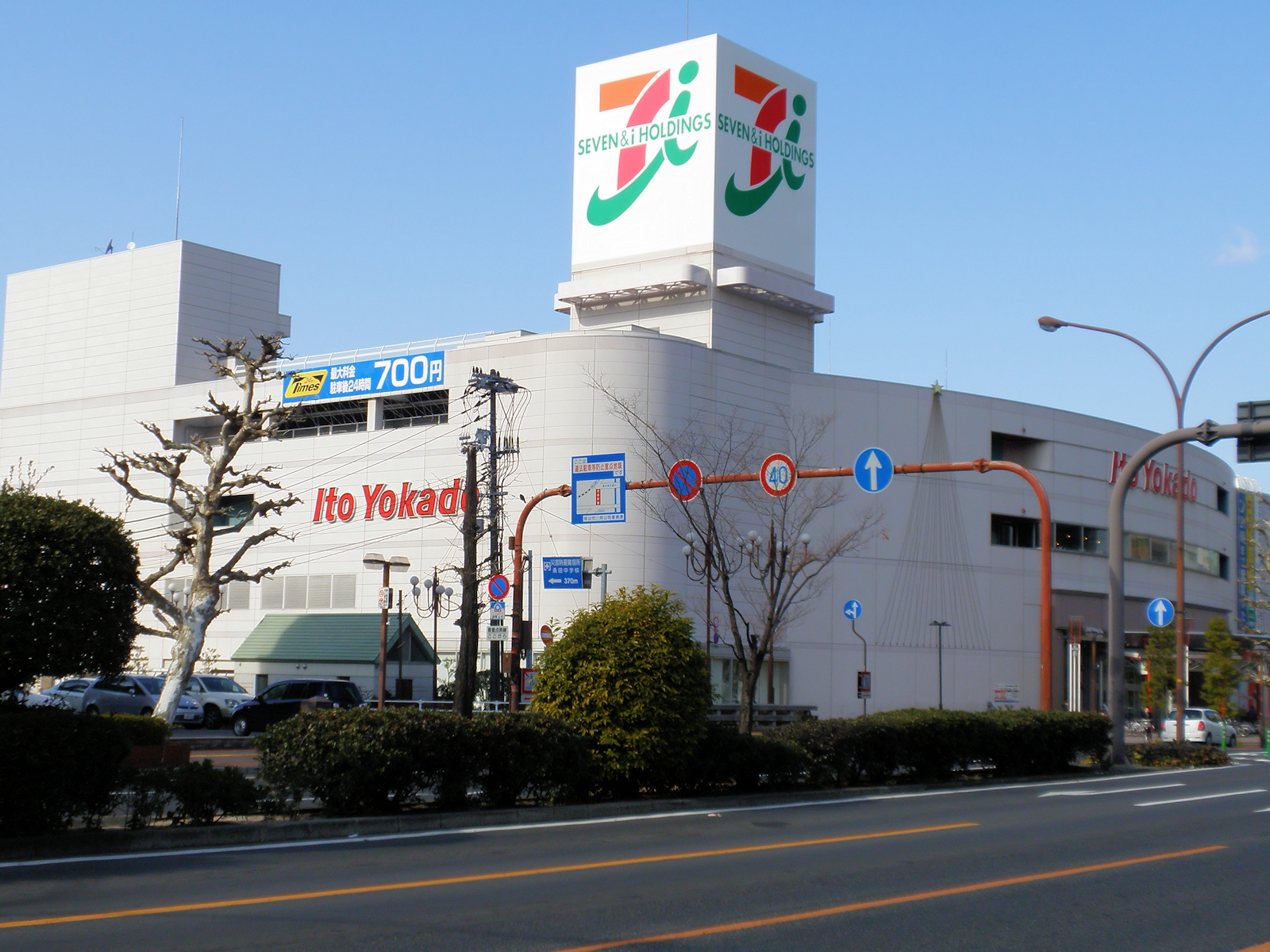|
Shakujii-kōen Station
is a railway station on the Seibu Ikebukuro Line in Nerima, Tokyo, Japan, operated by the private railway operator Seibu Railway. Lines Shakujii-kōen Station is served by the Seibu Ikebukuro Line from in Tokyo, with some services inter-running via the Tokyo Metro Yurakucho Line to and the Tokyo Metro Fukutoshin Line to and onward via the Tokyu Toyoko Line and Minato Mirai Line to . Located between and , it is 10.6 km from the Ikebukuro terminus. Station layout The station consists of two elevated island platforms serving four tracks. Platforms History The station first opened as on April 15, 1915, and was renamed Shakujii-kōen on March 1, 1933. The station was elevated on February 7, 2010 (platforms 3&4), April 17, 2011 (platform 2), and June 23, 2012 (platform 1). Station numbering was introduced on all Seibu Railway lines during fiscal 2012, with Shakujii-kōen Station becoming "SI10". Through-running to and from and via the Tokyu Toyoko Line and Minato ... [...More Info...] [...Related Items...] OR: [Wikipedia] [Google] [Baidu] |
Nerima, Tokyo
is a special ward in Tokyo, Japan. The ward refers to itself as Nerima City. , the ward has an estimated population of 721,858, with 323,296 households and a population density of 15,013 persons per km2, while 15,326 foreign residents are registered and 21.6% of the ward's population is over the age of 65. The total area is 48.08 km2. Districts and neighborhoods ;Kamiitabashi Area * Asahigaoka * Kotakechō ;Kaminerima Area * Asahimachi * Doshida * Hikarigaoka * Kasugacho * Mukōyama * Nukui * Tagara * Takamatsu ;Nakaarai Area * Nakamura * Nakamurakita * Nakamuraminami * Toyotamakami * Toyotamakita * Toyotamaminami * Toyotamanaka ;Nerima Area * Hayamiya * Hazawa * Heiwadai * Hikawadai * Kitamachi * Nerima * Nishiki * Sakaemachi * Sakuradai ;Ōizumi Area * Higashiōizumi * Minamiōizumi * Nishiōizumi * Nishiōizumimachi * Ōizumichō * Ōizumigakuen-chō ;Shakujii Area * Fujimidai * Kamishakujii * Kamishakujiiminami-chō * Miharadai * Minamitanaka * Sekimachikita * Se ... [...More Info...] [...Related Items...] OR: [Wikipedia] [Google] [Baidu] |
Ogikubo Station
is a railway station in Suginami, Tokyo, Japan, jointly operated by the East Japan Railway Company (JR East) and the Tokyo subway operator Tokyo Metro. Lines The JR East station is served by the Chūō Main Line (Chūō Line (Rapid) and Chūō-Sōbu Line local services), and is located 18.7 km from the starting point of the Chūō Line at Tokyo Station. The Tokyo Metro station is served by the , and forms the western terminus of the line from Ikebukuro. The station is numbered M-01. Station layout The JR East station consists of ground-level platforms running east–west, and the underground platforms for the Tokyo Metro station lie parallel to the JR East platforms, slightly to the south. The station has "North" and "South" ("South a" and "South b") entrances at the eastern end of the station and a "West" entrance at the western end. File:Ogikubo St North.jpg, The north entrance in June 2007 File:Ogikubo sta south b.jpg, The south b entrance in February 2008 File:Ogiku ... [...More Info...] [...Related Items...] OR: [Wikipedia] [Google] [Baidu] |
Haneda Airport
, officially , and sometimes called as Tokyo Haneda Airport or Haneda International Airport , is one of two international airports serving the Greater Tokyo Area, the other one being Narita International Airport (NRT). It serves as the primary base of Japan's two major domestic airlines, Japan Airlines (Terminal 1) and All Nippon Airways (Terminal 2), as well as Air Do, Skymark Airlines, Solaseed Air, and StarFlyer. It is located in Ōta, Tokyo, south of Tokyo Station. Haneda was the primary international airport serving Tokyo until 1978; from 1978 to 2010, Haneda handled almost all domestic flights to and from Tokyo as well as "scheduled charter" flights to a small number of major cities in East and Southeast Asia, while Narita International Airport handled the vast majority of international flights from further locations. In 2010, a dedicated international terminal, currently Terminal 3, was opened at Haneda in conjunction with the completion of a fourth runway, allowing l ... [...More Info...] [...Related Items...] OR: [Wikipedia] [Google] [Baidu] |
Bus Garage
A bus garage, also known as a bus depot, bus base or bus barn, is a facility where buses are stored and maintained. In many conurbations, bus garages are on the site of former car barns or tram sheds, where trams (streetcars) were stored, and the operation transferred to buses. In other areas, garages were built to replace horsebus yards or on virgin sites when populations were not as high as now. Description Most bus garages will contain the following elements: *Internal parking *External parking *Fueling point *Fuel storage tanks *Engineering section *Inspection pits *Bus wash *Brake test lane *Staff canteen/break room *Administration office Smaller garages may contain the minimum engineering facilities, restricted to light servicing capabilities only. Garages may also contain recovery vehicles, often converted buses, although their incidence has declined with the use of contractors to recover break-downs, and the increase in reliability. Overnight, the more valuable or regu ... [...More Info...] [...Related Items...] OR: [Wikipedia] [Google] [Baidu] |
Kichijōji Station
is an interchange passenger railway station serving Kichijōji in the city of Musashino, Tokyo, Japan, operated by East Japan Railway Company (JR East) and the private railway operator Keio Corporation. Lines Kichijōji Station is located on the JR East Chūō Main Line, and is served by all-stations Chūō-Sōbu Line services from and some Chūō Line (Rapid) limited-stop services from . It also forms a terminus of the Keio Inokashira Line and is located 12.7 kilometers from the opposing terminus at in Tokyo. The station is 14 minutes from Shinjuku and 28 minutes from Tokyo by Chuo Line rapid service, and 23 minutes from Shibuya by Inokashira Line express service. JR East Station layout The JR East station consists of two elevated island platforms serving four tracks. It has a "Midori no Madoguchi" staffed ticket office and a "View Plaza" travel agent. Platforms Keio Station layout The Keio station consists of two elevated side platforms serving two terminatin ... [...More Info...] [...Related Items...] OR: [Wikipedia] [Google] [Baidu] |
Narimasu Station
is a railway station on the Tobu Tojo Line in Itabashi, Tokyo, Japan, operated by the private railway operator Tobu Railway. Lines The station is served by the Tobu Tojo Line from in Tokyo. Located between and , it is from the Ikebukuro terminus. Express, Semi Express, and Local services stop at this station. During midday, six of the eight Local trains per hour terminate here, with the other two continuing to .Tobu Tojo Line Timetable, published March 2016 Station layout The station consists of two island platforms serving four tracks. Platforms 2 and 4 are used to allow faster trains to overtake slower stopping trains. This station has a season ticket sales office. Platforms File:Narimasu Station north entrance 20160719.jpg, The north entrance in July 2016 Narimasu Station ticket barriers 20160719.jpg, The ticket barriers in July 2016 Narimasu Station platforms up end 20120204.jpg, The platforms viewed from the up end in February 2012 Narimasu Station platforms down e ... [...More Info...] [...Related Items...] OR: [Wikipedia] [Google] [Baidu] |
Pharmacist
A pharmacist, also known as a chemist (Commonwealth English) or a druggist (North American and, archaically, Commonwealth English), is a healthcare professional who prepares, controls and distributes medicines and provides advice and instructions on the correct and safe use of medicines to achieve maximum benefit, minimal side effects and to avoid drug interactions. They also serve as primary care providers in the community. Pharmacists undergo university or graduate-level education to understand the biochemical mechanisms and actions of drugs, drug uses, therapeutic roles, side effects, potential drug interactions, and monitoring parameters. This is mated to anatomy, physiology, and pathophysiology. Pharmacists interpret and communicate this specialized knowledge to patients, physicians, and other health care providers. Among other licensing requirements, different countries require pharmacists to hold either a Bachelor of Pharmacy, Master of Pharmacy, or Doctor of Pharmacy d ... [...More Info...] [...Related Items...] OR: [Wikipedia] [Google] [Baidu] |
Daycare
Child care, otherwise known as day care, is the care and supervision of a child or multiple children at a time, whose ages range from two weeks of age to 18 years. Although most parents spend a significant amount of time caring for their child(ren), child care typically refers to the care provided by caregivers that are not the child's parents. Child care is a broad topic that covers a wide spectrum of professionals, institutions, contexts, activities, and social and cultural conventions. Early child care is an equally important and often overlooked component of child's developments. Care can be provided to children by a variety of individuals and groups. Care facilitated by similar-aged children covers a variety of developmental and psychological effects in both caregivers and charge. This is due to their mental development being in a particular case of not being able to progress as it should be at their age. This care giving role may also be taken on by the child's extended f ... [...More Info...] [...Related Items...] OR: [Wikipedia] [Google] [Baidu] |
Muji
(), or is a Japanese retail company which sells a wide variety of household and consumer goods. Muji's design philosophy is minimalist, and it places an emphasis on recycling, reducing production and packaging waste, and a no-logo or "no-brand" policy. The name Muji is derived from the first part of ''Mujirushi Ryōhin'', translated as ''No-Brand Quality Goods'' on Muji's European website.MUJI Online - ABOUT MUJI retrieved on 2009-10-02. Products and businesses  Muji started with only 40 products in the 1980s. Some of their products include pens, pencils, notebooks, storage units ...
Muji started with only 40 products in the 1980s. Some of their products include pens, pencils, notebooks, storage units ...
[...More Info...] [...Related Items...] OR: [Wikipedia] [Google] [Baidu] |
Nihon Keizai Shimbun
''The Nikkei'', also known as , is the flagship publication of Nikkei, Inc. (based in Tokyo) and the world's largest financial newspaper, with a daily circulation exceeding 1.73 million copies. The Nikkei 225, a stock market index for the Tokyo Stock Exchange, has been calculated by the newspaper since 1950. It is one of the four national newspapers in Japan; the other three are ''The Asahi Shimbun'', the ''Yomiuri Shimbun'' and the ''Mainichi Shimbun''. History The roots of the Nikkei started with an in-house newspaper department of Mitsui & Company in 1876 when it started publication of ''Chugai Bukka Shimpo'' (literally ''Domestic and Foreign Commodity Price Newspaper''), a weekly market-quotation bulletin. The department was spun out as the ''Shokyosha'' in 1882. The paper became daily (except Sunday) in 1885 and was renamed ''Chugai Shōgyō Shimpo'' in 1889. It was merged with ''Nikkan Kōgyō'' and ''Keizai Jiji'' and renamed ''Nihon Sangyō Keizai Shimbun'' in 1942. ... [...More Info...] [...Related Items...] OR: [Wikipedia] [Google] [Baidu] |
Ito Yokado
is a Japanese general merchandise and department store, originally founded in 1920. In 2005, it was reorganized, as part of a corporate restructuring, as a subsidiary of the Seven & I Holdings Co. As of March 2013, there are 178 Ito-Yokado stores operating in Japan. Since entering the Chinese market in 1997, opening their first store in the Chunxilu shopping district of Chengdu, the company has been operating eight stores in Beijing and six in Chengdu. The company formed a joint venture with Wangfujing Department Store and China Huafu Trade & Development Group Corp. to open one of five stores in Beijing. As of January 2013, there are fourteen Ito-Yokado stores in China. Musical Codes Inside Ito-Yokado, the staff working at the register can play instrumentals of famous musical pieces, which is a code to workers in the store for specific things to do. These are: * ''Help!'' - (The Beatles) - A call for additional staff to man the tills during periods of high customer traffic ... [...More Info...] [...Related Items...] OR: [Wikipedia] [Google] [Baidu] |





